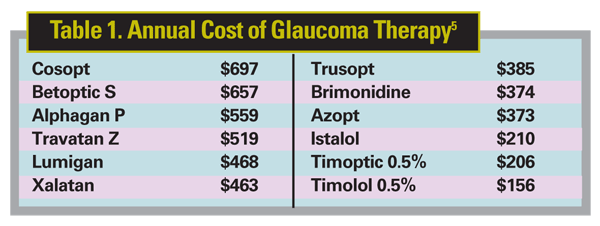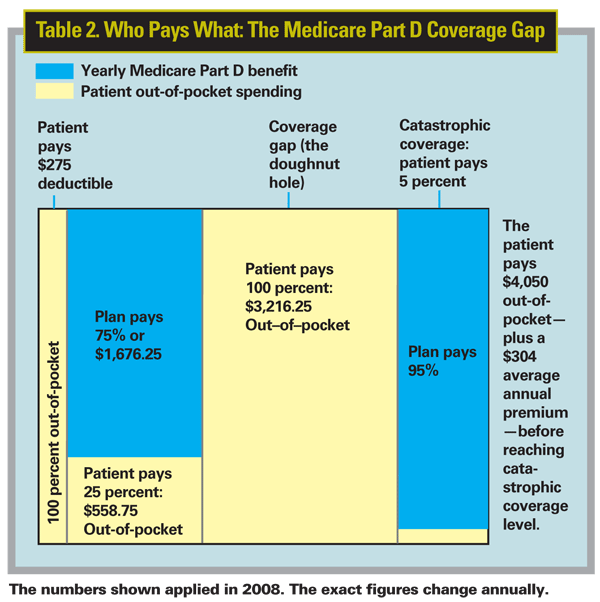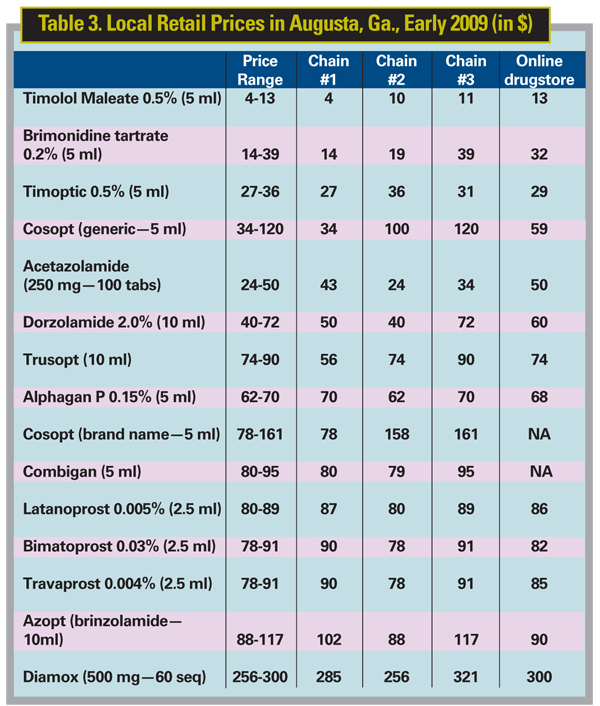When the Glaucoma Clinical Committee for the American Society of Cataract and Refractive Surgery met last November to discuss topics we wanted to cover at the next Glaucoma Subspecialty Day, one question we asked was: What have we been doing differently this past year? An answer that came up repeatedly was "prescribing more beta-blockers and fewer prostaglandins."
Of course, beta-blockers are a time-tested glaucoma treatment with advantages such as reduced red eye, but the prime reason cited for the change in prescribing was cost to the patient. As a general rule, beta-blockers are less expensive than prostaglandins and, as the economy has deteriorated, paying less for prescriptions has become an increasingly serious concern for many patients.
Clearly, it's important to know if our patients are having difficulty affording the medications we prescribe. If cost becomes an issue, patients may "stretch" the prescription or simply stop using it. A 2003 survey of 9,290 patients found that 17 percent listed cost as a reason for failing to comply with a treatment regimen1—and the economy was in far better condition at that point than it is today.
Taking Cost into Account
Doctors have always been aware of this issue; a study in 2000 found that 88 percent of doctors considered cost to be an important consideration when deciding what to prescribe, and 71 percent said they'd sacrifice efficacy if doing so made a prescription more affordable.2 Only 8 percent said they'd prescribe a brand name medication instead of a generic regardless of the cost. At the same time, their unease about cost was mitigated by other factors: 94 percent of the respondents thought medication costs were a strong concern when prescribing for patients with no insurance; 68 percent thought costs were a concern when prescribing for Medicare patients; and only 33 percent thought medication costs were a concern when prescribing for patients with HMO coverage.

Those financial concerns are still active. During my presentation on this topic at the ASCRS meeting, I asked the audience how they would treat an average POAG patient who is enrolled in a prescription drug plan; later I asked what their choice would be if the patient had no insurance and was facing economic hardship because of the current recession. The answers to the first question favored prostaglandins; the answers to the second question shifted dramatically toward beta-blockers and laser trabeculoplasty (the latter being paid for by Medicare). Despite the limited sample, it's clear that ophthalmologists treating glaucoma today are taking the patient's economic status into consideration.
In reality, there are enough ways to manage cost concerns that no patient should have to try to stretch his supply of drops to avoid financial pain. However, there are some significant obstacles to an ophthalmologist helping his patients avoid drug-cost difficulties. For one thing, many doctors don't know what their patients are paying for their prescriptions. (The study mentioned earlier found that 80 percent of doctors were unaware of what patients were actually paying.)
There are at least four good reasons for this: First, multiple, complex factors affect the cost each patient ends up paying (more about that in a moment). Second, we only get to spend a few minutes with each patient, which doesn't leave us a lot of time to inquire about financial constraints and concerns. Third, patients themselves are often clueless about the costs they are paying—or will be paying later as their insurance changes, or critical cut-off points in their existing insurance are reached. Fourth, ophthalmologists don't take any educational courses that address this kind of issue. The pharmacy training we receive consists of drug reps coming to our offices saying, "You need to prescribe this latest brand-name drug because it combines two meds in one drop or has a better preservative and will increase compliance." They don't mention that it may cost more than $100 a month.
Factors Affecting Patient Cost
Here are just a few of the factors that can change what your patient ends up paying for a prescription:
• The specifics of the individual's insurance plan. If retail pricing were the only issue here, lowering patient cost would be easy: Beta-blockers cost less than prostaglandins. (See Table 1) But most patients have insurance coverage, and that makes this equation far more complex.
Obviously, different plans have different copays and deductibles. They may also place drugs under different pricing tiers. We've noted that Xalatan, Lumigan and Travatan can be listed as either tier 2 or tier 3, depending on the particular insurance plan. That could influence which of the prostaglandins I prescribe, because a tier-3 prostaglandin could cost the patient $40 or $50 a month, while a tier-2 prostaglandin may only cost $20 to $30.

Different plans may also cover significantly different amounts of the cost. For example, suppose you prescribed a prostaglandin drop for a 66-year-old, healthy patient with primary open-angle glaucoma. Let's say the retail price in the store at which he likes to shop is $78 per month. An average prescription drug plan might lower the cost to $40. A standard Medicare benefit might lower it to $20; a Medicare partial subsidy could lower it to $12. It could be $6 with a Medicare full subsidy or $3 with Medicare dual eligibility. If the patient qualified as an indigent, it could be free under one of the programs sponsored by the major pharmaceutical companies.
One of the ironies here is that while beta-blockers are uniformly less expensive than prostaglandins in terms of retail price, depending on the patient's insurance and financial status, some patients may end up spending the same for a prostaglandin or a beta-blocker.
• Where an insured patient is in terms of deductible, or factors such as Medicare's "doughnut hole." Having to pay a deductible before our insurance kicks in is a familiar ritual, but Medicare has added a new wrinkle with its "doughnut hole" payment structure. This structure causes the amount covered by the insurance to drop dramatically above a certain expenditure level; the only reprieve beyond that point occurs when so-called "catastrophic coverage" kicks in after expenditures have risen to a much higher level. That extra range in which coverage is minimal is referred to as the doughnut hole. (See Table 2)
The doughnut hole is a big issue. Suppose a patient is using a prostaglandin. Let's say the going retail price is $70 per month, but this patient's insurance plan considers it to be a tier-2 drug. Her cost might be $40 a month until her deductible is met and she reaches Stage 2, when the price drops to $20 per month. Her glaucoma drop expenditures combine with other medicine costs to eventually push her total to Stage 3, or the doughnut hole, probably close to the end of the year. Now all of a sudden the drug is $70 a month and it's November. She knows that once the calendar reaches January, the drug price will drop to the deductible level and the cycle will begin again.
The problem is obvious; patients who can't easily afford this price increase may decide to take the drug every other night to make it last longer, or even skip it altogether. In our practice, we've noticed a decrease in medication use by patients who have lost their coverage because of the doughnut hole. And the reality is that most patients won't spend nearly enough on drugs to reach "catastrophic coverage."

It is true that the doughnut hole structure doesn't apply to everyone on Medicare; it only applies to those enrolled in the standard Part D benefit program. There are several Part D levels, and which one patients fall under depends on their annual income as a percentage of the Federal Poverty Level. (For 2009, the FPL ranges from $10,830 for a family of one to $37,010 for a family of eight within the contiguous
According to data from the Center for Medicare & Medicaid Services, almost half of the Medicare Part D patients are eligible for extra financial help through low-income subsidies. However, as of January 2008, only 37 percent of the 25 million people enrolled in Medicare Part D plans were not subject to the doughnut hole.3
• Prices where the patient prefers to shop. These days an increasing number of Americans have lost insurance coverage, or are unable to afford it in the first place. Data from 2007 and 2008 suggested that about 5 percent of Americans were paying for medications totally out-of-pocket, but that number may have increased with the economic downturn.4 In any case, it still may represent a significant number of patients in a given practice. For these patients, retail price makes all the difference.
I recently spent several weeks researching the cost of medicine at retail outlets within 10 miles of my office in
Some drugs, like Cosopt, ranged in price from $30 to $100. Ironically, some people will go far out of their way to save a few cents per gallon on the price of gas for their car, but it doesn't occur to them that the price of their glaucoma medication could vary 100 times more than that. And as far as I know, these prices are not advertised anywhere.
• The patient's personal financial status. This affects what level of Medicare Part D coverage the patient is eligible for. Also, the patient may be eligible for free medications if he or she meets the qualifications for one of the pharmaceutical industry's free assistance programs.
Easing Your Patients' Burden
So: What strategies can a practice employ to help avoid non-compliance caused by trouble paying for medications?
• Ask patients whether they're having trouble affording their meds. All of our patients come in trying to look nice. No one has indigent or I'm in the doughnut hole stamped on their forehead. Of course, for many patients, discussing their financial situation is uncomfortable. But some of them will be relieved, and everybody wants to pay as little as possible, so no one should take offense if you emphasize that your motive is making sure the patient doesn't pay any more than necessary.
• Use staff to help address this issue with patients. Clearly, the physician can't spend too much time on this when there are many patients to treat. For that reason you should have a staff member who can pursue the matter further and find ways to help the patient afford the medication. I have two employees who work on this with our patients.
• Stay aware of what local sources are charging for medications. Have someone on your staff research this periodically and keep you apprised of his or her findings so you can share them with patients, as appropriate. For example, I know that one chain in our area is selling Timoptic at a cost of $10 for a three-month supply; for that reason, my prescription rate for timolol over the past six months has been much higher than it was in the past. I make a point of telling these patients that they can get the prescription inexpensively at that local retailer.
• Help patients find the best insurance plan, given the meds they take. Comparing insurance plan options is especially useful when a patient is getting ready to switch to Medicare, but could be a helpful, eye-opening experience at any point. (Medicare, for example, provides a website that allows you to list the drugs you're taking and see which of the insurance plans in your area would lower your costs the most. You can access this site at http://www.medicare.gov/MPDPF/Public/Include/DataSection/Questions/MPDPFIntro.asp.)
• If appropriate, help patients enroll in indigent medication programs. Alcon, Merck, Allergan and Pfizer all have programs that provide medications to patients who can't otherwise afford them. In order to be eligible for this kind of help, patients must not have insurance that covers drugs, and must have an annual income below a specific level. (See the company websites for more specific information.) All of the companies are good about providing the free meds, but they don't make it easy to "join the club." For that reason, two members of our staff are experienced at helping eligible patients complete the paperwork.
• Provide patient education on applying drops. Wasted drops will certainly add to a patient's financial burden by causing meds to run out too quickly. Many studies have demonstrated that patients may have trouble getting their drops onto their eyes; even if their aim is good, they may squeeze the bottle too hard and use too many drops.
Instruction can make a difference, so we have ancillary staff that watches the patient put in a drop and then gives them tips. We also provide videotapes with more thorough guidance.
Helping Patients Help Themselves
Compliance is a concern even when times are good, so it's important for all of us to help our patients maintain their treatment regimens through this uncertain economic period.
Unfortunately, there are no easy answers about the best way to do this. Probably the most important thing to do is to simply be aware that patients are facing real obstacles to following your instructions, and let them know that you're ready and able to help.
Dr. Fechter is in private practice with Eye Physicians and Surgeons.
1. The Hidden Epidemic: Finding a Cure for Unfilled Prescriptions and Missed Doses. The
2. Reichert S, Simon T, Halm EA. Physicians' attitudes about prescribing and knowledge of the costs of common medications. Arch Intern Med. 2000;160:18:2799-2803.
3. Pfizer U.S. Pharmaceutical Group Formulary Lives Analysis, 2008.
4. Method of Payment: November 2007–April 2008. Data on File. Pfizer Inc,
5. Rylander NR, Vold SD. Cost Analysis of Glaucoma Medications. Am J Ophthalmol 2008;145:106–113.



